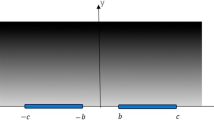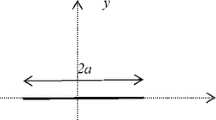Abstract
The classical linear elastic fracture mechanics is not valid near the crack tip because of the unrealistic singular stress at the tip. The study of the physical nature of the deformation around the crack tip reveals the dominance of long-range atomic interactive forces. Unlike the classical theory which incorporates only short range forces, a higher-order continuum theory which could predict the effect of long range interactions at a macro scale would be appropriate to understand the deformation around the crack tip. A simplified theory of gradient elasticity proposed by Aifantis is one such grade-2 theory. This theory is used in the present work to numerically analyze plane cracks in strain-gradient elastic materials. Towards this end, a 36 DOF C1 finite element is used to discretize the displacement field. The results show that the crack tip singularity still persists but with a different nature which is physically more reasonable. A smooth closure of the structure of the crack tip is also achieved.
Similar content being viewed by others
References
(a) Altan B, Aifantis EC (1992) On the structure of the mode III crack tip in gradient elasticity. Scripta Metall 26:319 (b) Ru CQ, Aifantis EC (1993) A simple approach to solve boundary-value problems in gradient elasticity. Acta Mech 101:59 (c) Exadaktylos GE, Aifantis EC (1996) Two and Three Dimensional Crack Problems in Gradient Elasticity. J Mech Behav Mater 7(2):93–117
Barenblatt GI (1962) The Mathematical theory of equilibrium cracks in brittle materials. Adv Appl Mech 7:55
Cosserat EF (1909) Theorie des corps deformables. Paris, A. Hermann & Fils
Dasgupta S, Sengupta D (1990) A Higher-order triangular plate bending element revisited. Int J Numer Meth Eng 30:419–430
Eringen AC, Edelen DGB (1972) On non-local elasticity. Int J Eng Sci 10:233–248
Eisenberg MA, Malvern LE (1973) On finite element integration in natural coordinates. Int J Num Meth Eng 7:574–575
Goodier JN, Kanninen M (1966) Crack Propagation in a continuum model with non-linear atomic separation laws. Technical Report No 165. Division of Engineering Mechanics, Stanford University
Gehlen PC, Kanninen MF (1969) In: Kanninen MF, Adler WF, Rosenfield AR, Jaffe RI (eds) Inelastic Behavior of Solids, McGraw-Hill, New York, p 587
Kroner (1967) Mechanics of Generalized Continua. IUTAM Symposium Freudenstadt, Stuttgart
Mindlin RD (1964) Microstructure in linear elasticity. Arch Ration Mech Anal 16:51–78
Mindlin RD, Eshel NN (1968) On first strain-gradient theories in linear elasticity. Int J Solid Struct 4(1):109–124
Reddy JN (1993) An introduction to the finite element method. Mc Graw-Hill International Editions, Second Edition-1993, p 515
Sternberg, Muki (1967) The effect of couple-stresses on the stress concentration around a crack. Int J Solid Struct 3:69–95
Shi MX, Huang Y, Hwang KC (2000) Fracture in a higher-order elastic continuum. J Mech Phys Solid 48:2513–2538
Toupin RA, Gazis DC (1964) Surface effects and initial stress in continuum and lattice models of elastic crystals. In: Wallis RF (ed) Lattice dynamics, Proceedings of an international conference, pp 597–605
Weiner JH, Sanders WT (1964) Phys Rev 134:A1007–1015
Zienkiewicz OC, Taylor RL (1991) The finite element method: solid and fluid mechanics dynamics and non-linearity, vol 2, 4th edn. Mc Graw-Hill International Editions, p 23
Zienkiewicz OC, Taylor RL (1989) The finite element method: solid and fluid mechanics dynamics and non-linearity, vol 2, 4th edn. Mc Graw-Hill International Editions, p 14
Zervos A, Papanastasiou P, Vardoulakis I (2001) A Finite element displacement formulation for gradient elastoplasticity. Int J Numer Meth Eng 50:1369–1388
Zhang L, Huang Y, Chen JY, Hwang KC (1998) The mode III full-field solution in elastic materials with strain gradient effects. Int J Fracture 92:325–348
Author information
Authors and Affiliations
Corresponding author
Rights and permissions
About this article
Cite this article
Akarapu, S., Zbib, H.M. Numerical analysis of plane cracks in strain-gradient elastic materials. Int J Fract 141, 403–430 (2006). https://doi.org/10.1007/s10704-006-9004-y
Received:
Accepted:
Published:
Issue Date:
DOI: https://doi.org/10.1007/s10704-006-9004-y




